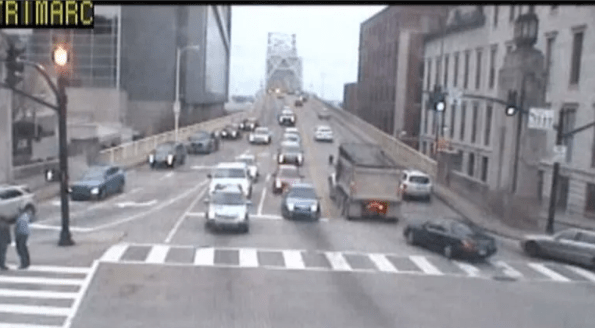Kentucky and Indiana just cut the ribbon on the new $1.3 billion "Downtown Crossing" bridge, part of the even bigger $2.6 billion "Ohio River Bridges" project, which encompasses two new bridges over the Ohio River and one enormous tangle of an interchange. The project was widely ridiculed for its outrageous expense and for degrading the connection between downtown Louisville and the riverfront.
To top it all off, the drivers the downtown bridge was built for -- suburban commuters whose travel time was deemed to be so important -- don't seem to appreciate it that much. Joe Cortright at City Observatory has been using live traffic cameras maintained by the Kentucky Transportation Cabinet to investigate traffic conditions on the brand new bridge. What he found on Tuesday at 5 p.m., which should be the height of rush hour, was an empty highway, shown above.
The new Downtown Crossing bridge costs between $1 and $3 to drive across. Cortright suggests this early evidence indicates that Kentucky and Indiana made a grave miscalculation:
This very anecdotal, if visual, information suggests a couple of hypotheses. First, it does appear that a fairly large segment of traffic crossing the Ohio River in Louisville on this particular afternoon chose the older, slower and non-tolled route over the newer, faster and more expensive tolled freeway bridges. Second, it seems like there is plenty of capacity crossing the Ohio River at this particular point to accommodate all these vehicles. Not only is the freeway nearly deserted, but traffic appears to be well below capacity on the Second Street Bridge as well.
Of course, this is a small sample and a highly unscientific set of observations. But taken at face value, these pictures call into question the decision to spend several billion dollars to increase highway capacity over the Ohio River. If so few cars are actually crossing the river at peak hour on a typical business day, and if such a relatively large proportion of them apparently prefer to use the older, slower route rather than pay to use the fancy new crossing, did the states of Kentucky and Indiana have any reason to spend so much to build a giant new bridge? And will the two states, who are counting on toll revenues to pay back a major share of the cost of the project, be able to cover their debts?
For comparison, here's a photo Cortright grabbed at the same time at the nearby Second Street Bridge, built in the 1920s, which has no toll:

As Cortright says, it's too early to reach conclusions. But this project will be an interesting one to watch.
Kentucky, especially, borrowed enormous sums to build these highway bridges, based on projected revenue from tolls. If the state's projections were off the mark, it could cost the public dearly. There are plenty of examples of new toll roads failing to make ends meet. In this case, residents of Kentucky and Indiana would be on the hook, as would people all over the country, since the feds helped guarantee the loans.
Correction: This post originally mislabled the bridge in the above photo as the "East End Bridge." It is the "Downtown Crossing Bridge."
More recommended reading today: BikeWalkLee carries a column explaining why Fort Myers, Florida, topped Smart Growth America's recent list of most dangerous cities for walking: It's a design failure. And the Political Environment wonders why no one in Wisconsin is mentioning higher speed limits as a factor in the rise in traffic deaths.






